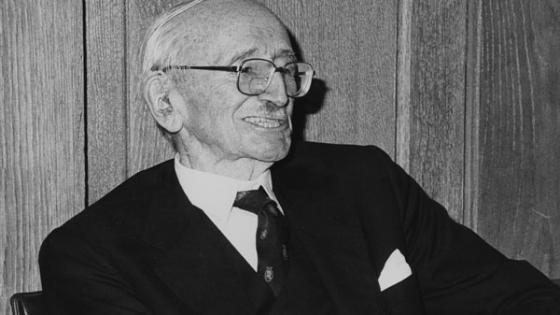Friedrich A Hayek (1899-1992), well ahead of his time, viewed the market economy as an information processing system characterised by spontaneous order – the emergence of coherence through the independent actions of large numbers of individuals, each with limited and local knowledge, coordinated by price messages that arise from a decentralised process of competition.
Hayek also advocated for a broad range of free market policies, and indeed considered the market system to be superior to competing alternatives precisely because it made the best use of dispersed knowledge. These political views included opposition not only to central planning, but also to monetary and fiscal demand management policies, collective bargaining, wage floors, and significant public expenditures. His hostility to Keynes and to Keynesian policies in particular was deep and visceral.
Hayek drew a sharp contrast between his approach and general equilibrium theory, which itself had been used to make a case for free markets on the basis of the fundamental theorems of welfare economics. As he put it, the “argument in favour of competition does not rest on the conditions that would exist if it were perfect” (Hayek 1948: 104). Instead, his case for competitive markets rested on the idea that competition was a “procedure for discovering facts which, if the procedure did not exist, would remain unknown or at least would not be used” (Hayek 1968).
We believe that Hayek’s economic vision and critique of equilibrium theory remain not only relevant, but apply with greater force, as information has become ever more central to economic activity and the complexity of the information aggregation process has become increasingly apparent. Advances in computational capacity and the growth of online transactions and communication have made the collection and rapid processing of big data feasible and profitable. Many markets now involve algorithmic price-setting and order placement alongside direct human action, raising interesting new questions about the processes by which information is absorbed and transmitted by prices.
However, shown in a recent paper (Bowles et al. 2017), we wish to call into question Hayek’s belief that his advocacy of free market policies follows as a matter of logic from his economic vision. The very usefulness of prices (and other economic variables) as informative messages – which is the centrepiece of Hayek’s economics – creates incentives to extract information from signals in ways that can be destabilising. Thus, we find considerable lasting value in Hayek’s economic analysis, while nonetheless questioning the connection of this analysis to his political philosophy.
Hayek on competition, equilibrium, and disequilibrium
Very early, Hayek (1937) defined equilibrium as a set of individual plans that could be executed without mutual interference. This allows for the possibility that individual beliefs depend upon local knowledge and differ, provided that these beliefs are not contradicted as plans unfold.
This notion of equilibrium is thoroughly modern, dynamic, and unrestrictive – and quite distinct from a general equilibrium model in which prices are uniform and public. Its development is a significant accomplishment in its own right and Hayek claimed later in life that it “seems to me in retrospect the most original contribution I have made to the theory of economics” (1994: 68).
But he was not particularly interested in the properties of equilibrium itself, and saw the strength of the market economy as arising from the learning and diffusion of new information that it accomplishes in disequilibrium. He argued that “the modern theory of competition deals almost exclusively with a state… in which it is assumed that the data for the different individuals are fully adjusted to each other, while the problem which requires explanation is the nature of the process by which the data are thus adjusted.” In particular, “competition is by its nature a dynamic process whose essential characteristics are abstracted away under the assumptions underlying equilibrium analysis” (Hayek 1948).
Hayek’s critique was aimed at the assumption of the passive, price-taking behaviour that is a defining feature of the Walrasian framework. Many of the phenomena that cannot be accommodated within this framework – advertising, undercutting, differentiating, reputation building, and relational contracting – as well as other related phenomena, such as bargaining and search, have been the focus of intense research effort over recent decades. These advances explicitly allow for opportunistic and entrepreneurial behaviour that goes well beyond the passive price-taking of agents in the Walrasian model.
In light of these contributions, is Hayek’s critique of Walrasian general equilibrium obsolete, something that should be left to history of economic thought courses?
We think not. Economic analysis largely continues to be based on characterisations of equilibrium states, without attention to the processes through which such states might (or might not) be reached. Contemporary models of strategic competition and search are equilibrium models, characterised by mutually consistent plans. These plans may have complicated features, with actions being contingent on history and the realisation of random variables, but there is a common understanding across all individuals regarding the structure of the economy in which they are embedded. Left unaddressed is the process through which such a common understanding might arise.
When prices are messages and entrepreneurial discovery is destabilising
While Hayek had little use for equilibrium theory, he did implicitly assume that the process of entrepreneurial discovery would be stabilising on average – that the profit opportunities that arose in disequilibrium would be exploited in a manner that sustained coherence and order in the system (Kirzner 1997). But the same problems of stability that have plagued general equilibrium theory also arise in the context of entrepreneurial discovery – individually profitable activities can be destabilising in the aggregate.
In fact, the interpretation of prices as signals can itself give rise to destabilising feedbacks, especially through the linkage of financial and goods markets. Since changes in asset prices can lead to substantial short-term capital gains and losses, information relevant to changes in such valuations will be actively sought. To the extent that an asset price rise can be used to infer that this happened as a result of the reaction of informed individuals to a change in the conditions of demand or supply, other individuals may seek to profit by buying and hoarding the asset in anticipation of further increases in price. But this activity itself has price effects, which in turn may result in rational hoarding by others, amplifying the destabilising process.
Such effects can be captured by models of information cascades in which herding arises as a rational response to the extraction of information from the actions of others (Banerjee 1992, Bikhchandani et al. 1992). In financial markets, attempts to extract information from prices can give rise to prolonged departures from fundamentals in theoretical models (Hong and Stein 1999, Abreu and Brunnermeier 2003), the empirical counterpart of which is excess volatility in prices (LeRoy and Porter 1981, Shiller 1981). When leverage is significant, relatively small informational shocks can give rise to large asset revaluations as funding dries up and assets must be liquidated at fire sale prices (Brunnermeier and Pedersen 2009, Adrian and Shin 2010, Geanakoplos 2010). Since information is costly to acquire and process, assets that have sufficient seniority are considered safe under normal conditions. These can suddenly start to be perceived as risky and “information-sensitive” in crisis conditions, causing trading volume to collapse or markets to shut down entirely (Gorton 2012).
Such phenomena do not remain confined to the financial sector. The prices of claims on future income flows inevitably affect current production and consumption decisions, and prices of goods and services will not track relative resource scarcity consistently and reliably when assets are mispriced. And the most information-sensitive markets are subject to some of the most spectacular failures.
Disequilibrium dynamics and complex adaptive systems
While Hayek himself did not develop a mathematical formulation of his vision, there do exist models of the economy as a complex adaptive system in which aggregate outcomes are determined by the social interaction of agents with limited and local knowledge. This so-called agent-based literature makes intensive use of computational rather than analytical methods, and focuses on disequilibrium adjustment rather than the characterisation of equilibrium paths. Epstein (2007) calls the approach generative, while Tesfatsion (2006) calls it constructive. Its connection to Hayek’s thought has been previously noted (Vriend 2002, Rosser 2012, Axtell 2016).
A key element in this literature is the absence of imposed coordination across individuals in actions and beliefs. There is no assumption that individual plans are mutually consistent, or that subjectively perceived laws of motion coincide with the objectively realised laws of motion to which these perceptions give rise. This does not, of course, rule out model-consistent expectations or market clearing as endogenous outcomes, arising through adaptation by individuals.
The agents in these models may be cognitively active units such as individuals, households, and firms, or inanimate components such as institutions for processing transactions or stocks of natural resources (Tesfatsion 2006). Agents may respond mechanically to inputs on the basis of physical laws or behavioural rules, or they may be sophisticated and forward-looking. They may be inter-temporal optimisers employing the same dynamic programming methods used in orthodox models, but subject to private beliefs rather than mutually consistent expectations.
The key difference is that “events are driven solely by agent interactions once initial conditions have been specified… rather than focusing on the equilibrium states of a system, the idea is to watch and see if some sort of equilibrium develops over time” (Tesfatsion 2006). Such models have been able to replicate patterns in financial market data such as excess and clustered volatility, short-run momentum, and mean reversion over longer horizons (LeBaron 2006, Hommes 2006).
Leijonhufvud (2006) has argued that agent-based process analysis “will finally make it possible to tackle the central problem of macroeconomics, namely, the self-regulating capabilities of a capitalist economy,” but that the method remains in its “technical infancy.” During the decade since that assessment, there have been attempts to build ambitious agent-based models of macroeconomic dynamics (Delli Gatti et al. 2008, Sinitskaya and Tesfatsion 2015), financial fragility (Mandel et al. 2015), and the housing bubble (Geanakoplos et al. 2012), and the approach has attracted attention at several central banks. It is only a matter of time before the methodology will reach a level of development at which fundamental questions at the core of the discipline can be systematically explored.
Hayek’s political philosophy
Hayek believed that his economic vision provided the foundation for his support for the unregulated workings of markets – “that our whole modern wealth and production could arise only thanks to this mechanism is, I believe, the basis not only of my economics but also much of my political views (Hayek 1994: 69). But a careful reading of The Road to Serfdom (1944) shows that he advocated minimal government because he saw hierarchical and collectivist political systems as a threat to individual liberty, not because his economics per se had demonstrated the superiority of unregulated markets.
The examples on his mind at the time – the Soviet Union under Stalin and Germany under Hitler – were convincing exhibits for his case. But, seven decades later, we have a record of sustained liberal democratic values in economies with substantial government involvement, and the evidence does not support his most dire predictions.
Ironically, the recent success of Hayek’s programme of limiting government may have contributed to an environment favourable to precisely the xenophobic and other anti-liberal sentiments and movements that now challenge democratic governance. But fortunately, Hayek’s economics and his political philosophy do not have to be taken as a package – one can appreciate his insights into the functioning of market economies without idealising the system itself.
References
Abreu, D, and M K Brunnermeier (2003), “Bubbles and crashes”, Econometrica 71 (1), 173-204.
Adrian, T, and H S Shin (2010), “Liquidity and leverage”, Journal of Financial Intermediation, 19 (3), 418-437.
Axtell, R L (2016), “Hayek Enriched by Complexity Enriched by Hayek”, Unpublished Manuscript, Department of Computational Social Science, George Mason University.
Banerjee, A (1992), “A simple model of herd behaviour”, Quarterly Journal of Economics, 108: 797–817.
Bikhchandani, S, D Hirshleifer, and I Welch (1992), “A theory of fads, fashion, custom, and cultural change as informational cascades”, Journal of Political Economy 100 (5), 992-1026.
Bowles, S, A Kirman, and R Sethi (2017), “Friedrich Hayek and the Market Algorithm”, Journal of Economic Perspectives.
Brunnermeier, M K, and L H Pedersen (2009), “Market liquidity and funding liquidity”, Review of Financial Studies 22(6), 2201-2238.
Delli Gatti, D, E Gaffeo, M Gallegati, G Giulioni, and A Palestrini (2008), Emergent Macroeconomics: An Agent-based Approach to Business Fluctuations, Springer Science & Business Media.
Epstein, J M (2007), Generative social science: Studies in agent-based computational modelling, Princeton University Press.
Geanakoplos, J (2010), “The Leverage Cycle”, NBER Macroeconomics Annual 2009, vol. 24, 1-65, University of Chicago Press.
Geanakoplos, J, R Axtell, D J Farmer, P Howitt, B Conlee, J Goldstein, M Hendrey, N M Palmer, and C-Y Yang (2012), “Getting at systemic risk via an agent-based model of the housing market”, The American Economic Review 102 (3), 53-58.
Gorton, G (2012), Misunderstanding financial crises: Why we don't see them coming, Oxford University Press.
Hayek, F A (1937), “Economics and Knowledge”, Economica, 33-54.
Hayek, F A (1944), The Road to Serfdom, Chicago: University of Chicago Press.
Hayek, F A (1945), “The Use of Knowledge in Society”, American Economic Review 35(4), 519-30.
Hayek, F A (1948), “The meaning of competition”, In Individualism and Economic Order, Chicago: University of Chicago Press.
Hayek, F A (1979), Law, legislation and liberty: A new statement of the liberal principles and political economy. Volume III: The political order of a free people, Chicago: University of Chicago Press.
Hayek, F A (1994), Hayek on Hayek: An Autobiographical Dialogue, edited by S Kresge and L Wenar, Chicago: University of Chicago Press.
Hayek, F A (2002), “Competition as a Discovery Procedure”, Quarterly Journal of Austrian Economics 5 (3), 9-23. (originally published in German in 1968).
Hommes, C H (2006), “Heterogeneous agent models in economics and finance”, Handbook of Computational Economics, 2, 1109-1186.
Hong, H, and J C Stein (1999), “A unified theory of underreaction, momentum trading, and overreaction in asset markets”, The Journal of Finance 54 (6), 2143-2184.
Kirzner, I M (1997), “Entrepreneurial discovery and the competitive market process: An Austrian approach”, Journal of Economic Literature 60-85.
LeBaron, B (2006) “Agent-based computational finance”, Handbook of Computational Economics 2, 1187-1233.
Leijonhufvud, A (2006), “Agent-based macro”, Handbook of Computational Economics, 2, 1625-1637.
LeRoy, S F, and R D Porter (1981), “The present-value relation: Tests based on implied variance bounds”, Econometrica: Journal of the Econometric Society 555-574.
Mandel, A, S Landini, M Gallegati, and H Gintis (2015), “Price dynamics, financial fragility and aggregate volatility”, Journal of Economic Dynamics and Control 51: 257-277.
Rosser, J B (2012), “Emergence and complexity in Austrian economics”, Journal of Economic Behavior & Organization 81 (1), 122-128.
Shiller, R J (1981), “Do Stock Prices Move Too Much to be Justified by Subsequent Changes in Dividends?”, The American Economic Review 71 (3), 421-436.
Sinitskaya, E, and L Tesfatsion (2015), “Macroeconomies as constructively rational games”, Journal of Economic Dynamics and Control, 61, 152-182.
Tesfatsion, L (2006), “Agent-based computational economics: A constructive approach to economic theory”, Handbook of Computational Economics, 2, 831-880.
Vriend, N J (2002), “Was Hayek an Ace?”, Southern Economic Journal 68 (4), 811-840.






